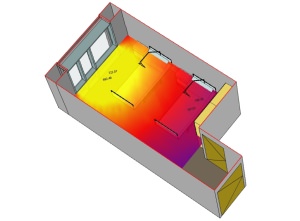We put things in the right light test
Who doesn’t yearn for a friendly sunbeam and a little bit more light on dark winter days?
Or what if the sun is shining, but it’s difficult to see your computer screen? External sun protection is not always the solution, because it makes the inside of the building dark again.
We develop targeted daylighting planning measures based on calculations and analyses so that daylight is used as effectively as possible indoors.

DAYLIGHT SIMULATIONS
Daylight is a vital component of nature for people – from both a physiological and psychological point of view.
Daylight affects the human body in many ways. It is scientifically proven that there is a direct correlation between performance and exposure to daylight.
Using complex daylight simulation programs we examine all issues concerning light supply and sun protection, visual contact to the outside world and the prevention of glare.
Linking daylight simulation and building energy balance assessment enables us to optimize energy concepts while ensuring thermal insulation in summer and an adequate supply of daylight.
We even consider efficient workplace conditions for our clients prior to the implementation from various angles in terms of structural physics. This makes it possible, for example, to integrally evaluate the effectiveness of cost-intensive daylight control systems from an economic perspective.
Three-dimensional models are used to map, analyze and represent the key parameters for the evaluation of visual comfort.
We are specialists in the following areas:
- Determination of the illuminance and daylight factors on work surfaces
- Representation of the hourly distribution of the illuminance at the user level for different sky models
- Photorealistic and detailed representation of the exposure situation of rooms and buildings
- Assessment of visual comfort according to standards, workplace regulations and German Sustainable Building Council (DGNB) criteria
- Analysis of the energy input needed to ensure the required illuminance
- Determination of the annual daylight and artificial lighting utilization time

